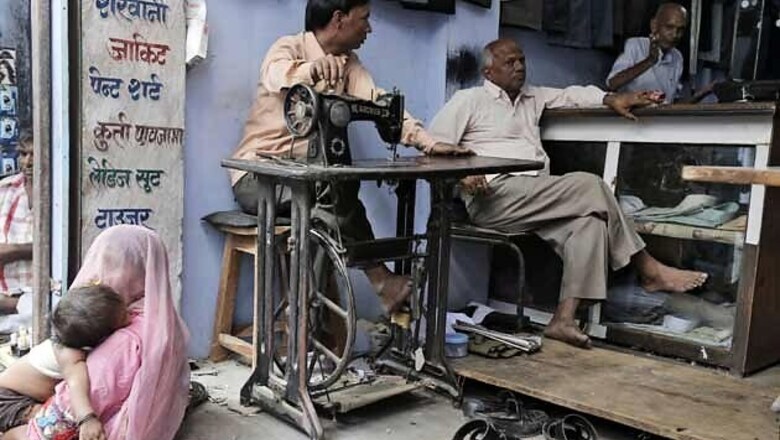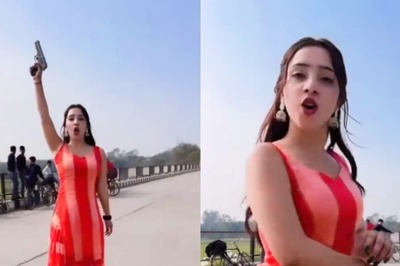
views
Jaipur: Kasba Bonli is a newly prosperous market town in Rajasthan and it should be a perfect advertisement for the ruling Congress party's pro-farmer policies. Instead the buzz in the bazaar is for the Opposition Bharatiya Janata Party (BJP).
In just a few years, handouts for farmers by that Congress have helped turn the once-deprived village into a thriving retail centre, selling everything from glittery bangles to satellite dishes.
The Congress party-led government pours at least $20 billion a year into rural India in addition to free education and health and cheap food. Cheap fertiliser, seeds and electricity, 100 days of guaranteed paid work a year and new rural roads have given farmers cash to spend.
These funds have helped create an emerging middle class, mostly in semi-urban and small towns, which one estimate has put at almost a quarter of India's 1.2 billion people.
But many in this new middle class believe the next step up the income ladder will come when the opposition BJP and Narendra Modi, its candidate for prime minister and currently the chief minister of Gujarat, will be in power. That bodes ill for the Congress ahead of a general election that must be held by May.
Farmer Raghuvir Meena, who voted for the Congress in the last state polls, bought two new tractors over the past few years and nearly doubled his farming area, attributing the prosperity to better farming techniques and seeds. He sent three of his four children to college to train as teachers. Now he wants to get out of farming and this time Modi has his vote.
"Modi's track record in Gujarat has excited the youth. Even I would love to see BJP come back to power, for my kids, for their jobs," he said, juggling phone calls on his mobile.
Modi is widely seen as a business-friendly reformer who has attracted investment and bolstered economic growth in Gujarat, providing jobs to many.
For Congress this trend in the small towns is the latest in a series of reverses. It is already battling slowing economic growth, perceptions of poor governance, several corruption scandals and the growing popularity of Modi.
For decades, the Congress relied on its pro-farmer policies giving it rural votes. Then, at the last election in 2009, it gained wide support in cities during a period of fast economic growth to win a second consecutive term in office.
However, the urban goodwill is fast eroding because of corruption and a sense of policy drift, while its base constituency of rural poor is shrinking.
"It's a new phenomenon. It's not something that we have been used to in the past," said Rural Development Minister Jairam Ramesh, of the demographic shift.
"Very often experience shows that beneficiaries of programmes instituted by one party end up voting for the other political party," he said.
Modi's allure
Beyond the commercial bustle, Kasba Bonli has little to offer to the groups of twenty-somethings who loiter on motorcycles in the dusty market, unable to find work.
Often the first graduates in their families, these young men say they want industries and professional jobs rather than more handouts, and they look to Modi for providing such opportunities, not the Congress.
Modi has attracted companies such as Ford Motor Co, Maruti Suzuki and Tata Motors to Gujarat, the state he has governed since 2001.
But he is also seen as a polarising figure. Critics of Modi, a Hindu nationalist, say he didn't do enough to stop religious riots on his watch in 2002 that killed at least 1,000 people, mainly Muslims, although the allegations have never been proved. Others say that despite fast growth, his state is a laggard on social and poverty indicators.
That's not the impression held by Mateem Khan, a frustrated 22-year-old Muslim resident of Kasba Bonli with a lowly data-entry job at the local office for one of the handout schemes, the only skilled work he could find.
"Look at what he has done for Gujarat, there's hardly any unemployment in the state," said Khan. Kasba Bonli's 18,000 people are about half Muslim and half Hindu.
Four banks, 15 private schools, and one private college have sprouted up in the town since 2008, said Ramkishan Gurjar, head of the village council that governs Kasba Bonli. Motorcycle and tractor showrooms have come up over the past three years.
Many local farmers now clutch mobile phones they use to chat to traders about crop prices. Roads have been built to a dozen surrounding villages, helping bring crops quickly to market and consumer goods flowing the other way.
It's a pattern repeated across the country, with swollen villages becoming small towns, creating a demographic group of relatively better off semi-urban voters that barely existed a decade ago, social scientists and politicians say.
Rural consumer spending grew by 36 per cent, higher than the 33 per cent rise in urban areas, between 2009 and 2012, according to government data.
A national census in 2011 found that 14 per cent of India's urban population of about 400 million lived in these towns, double that of a decade earlier. Boston Consulting Group calculates 24 per cent of Indian households are now found in small towns.
Making headway
Modi has directly addressed this demographic shift, catering speeches to the new constituency and promising urban amenities such as around-the-clock electricity and broadband Internet connections to communities similar to Kasba Bonli.
Opinion polls suggest he is making headway. In a recent Nielsen survey of two largely rural states, Bihar and Uttar Pradesh, that contain a quarter of India's population, Modi emerged as the most popular candidate for prime minister.
In Rajasthan, the state in which Kasba Bonli lies, the Congress and the BJP are neck and neck in the villages with support from 46 per cent of voters each, according to a July poll by the Centre for the Study of Developing Societies (CSDS), a think-tank.
However, in towns of less than 100,000 people, which fall under the semi-urban category, BJP scored 56 per cent to Congress's 40 per cent.
India electoral mathematics is complicated, taking in local issues as well as caste and religion, making it hard to forecast results. But Rajasthan and four other states hold provincial elections over the next month, which will provide a pointer to how far Modi's popularity extends and how Congress may fare in the national election.
"If you look at people in the (semi-urban) category, they have benefited from education and reservation policies for lower castes. But increasingly our surveys show that, as people get more educated and affluent, the possibility of them voting for the BJP is much higher," said Sanjay Lodha, who co-ordinates CSDS' polls in Rajasthan.



















Comments
0 comment